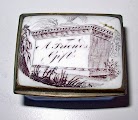 Today I looked at manicures in the 18th Century. Hands do so much, and generally do not receive the treatment they deserve. They not only do utilitarian things, but the artistic as well. They allow us to play the piano, the guitar, the violin, the clarinet, frankly practically any musical instrument. They pick up the paint brush, and look at the marvels we have that grace our museum walls. They have sculpted, they have written. They massage, they type, they sew, they help us to feel the world around us.
Today I looked at manicures in the 18th Century. Hands do so much, and generally do not receive the treatment they deserve. They not only do utilitarian things, but the artistic as well. They allow us to play the piano, the guitar, the violin, the clarinet, frankly practically any musical instrument. They pick up the paint brush, and look at the marvels we have that grace our museum walls. They have sculpted, they have written. They massage, they type, they sew, they help us to feel the world around us.
And what do we do for them? Well, some people get weekly or monthly manicures, but most of us have them relegated to the position of slaves, doing our bidding, without a "how do you do?!" Doing housework, using cleaning fluids, waxing cars, going without gloves in the cold, inflicting an occasion burn at the stove, and the list goes on and on.
I love my hands, though, not for their beauty, though once they were quite the thing, if I do say so myself. But today I love them because they are my friends, and they remind me of my family. I have one hand with fingers that remind me of my Dad's, and both my hands look more and more like my Mom's, and she and I are both inclined to the arts. I always loved her hands, and now I understand why. She has used them to create, and they show that endeavor! It's a beautiful thing.

But how did people treat them in the 1700's. Well, I looked at manicures of the times, and found that nails were oiled and buffed with suede until they gleamed. Generally, a very fine abrasive powder was used for the buffing. Sometimes the oils were lightly tinted or scented, but nail polish was not used until the 1920's, and then came the loud, roaring reds along with white or pink moons left unvarnished at the base of the nail. The French manicure, by the way, originated in the 18th century in Paris. French manicures are designed in a way to resemble natural nails with pink color on nails and white color on tip of nails, but seen very seldom at that time.
Actually, there were paints used going way back to ancient times, but in the 18th Century, they were en vogue, not for the elegant. Gentle ladies did not use their hands for utilitarian purpose, except to wave a fan, or apply a dab of perfume, or play the lute, or pianoforte. Women, however, used them to clean clothing, wash children, make bread, harvest crops, etc etc but they never would be thinking of care of the hands, no less a manicure.
There exist many lovely manicure grooming kits and tools from the 18th Century. Some have little picks, tiny scissors, files, and of course, buffers. Some of the best are of sterling silver, with gold or ormolu. And I would gather your ladies-in-waiting did the work. There's always a "slave" involved where the glitterati abound, today or yesterday.










 And so, I stick with stores or shops that have stood the test of time, receiving the royal warrants, offering the best of what money can buy! Like D.R. Harris & Co., the official chemist to the Prince of Wales! A place to pick up special perfumes, sartorial items like shaving brushes, etc. Though a small place, it even supplies small first class passenger items to British Airways.
And so, I stick with stores or shops that have stood the test of time, receiving the royal warrants, offering the best of what money can buy! Like D.R. Harris & Co., the official chemist to the Prince of Wales! A place to pick up special perfumes, sartorial items like shaving brushes, etc. Though a small place, it even supplies small first class passenger items to British Airways. 


 Royal warrant of appointment have been issued for centuries to those who supply goods or services to a royal court or certain royal personages. The warrant enables the supplier to advertise the fact that they supply to the royal family, so lending prestige to the supplier. In the United Kingdom, grants are currently made by the three most senior members of the British Royal family to companies or tradesmen who supply goods and services to individuals in the family.
Royal warrant of appointment have been issued for centuries to those who supply goods or services to a royal court or certain royal personages. The warrant enables the supplier to advertise the fact that they supply to the royal family, so lending prestige to the supplier. In the United Kingdom, grants are currently made by the three most senior members of the British Royal family to companies or tradesmen who supply goods and services to individuals in the family.